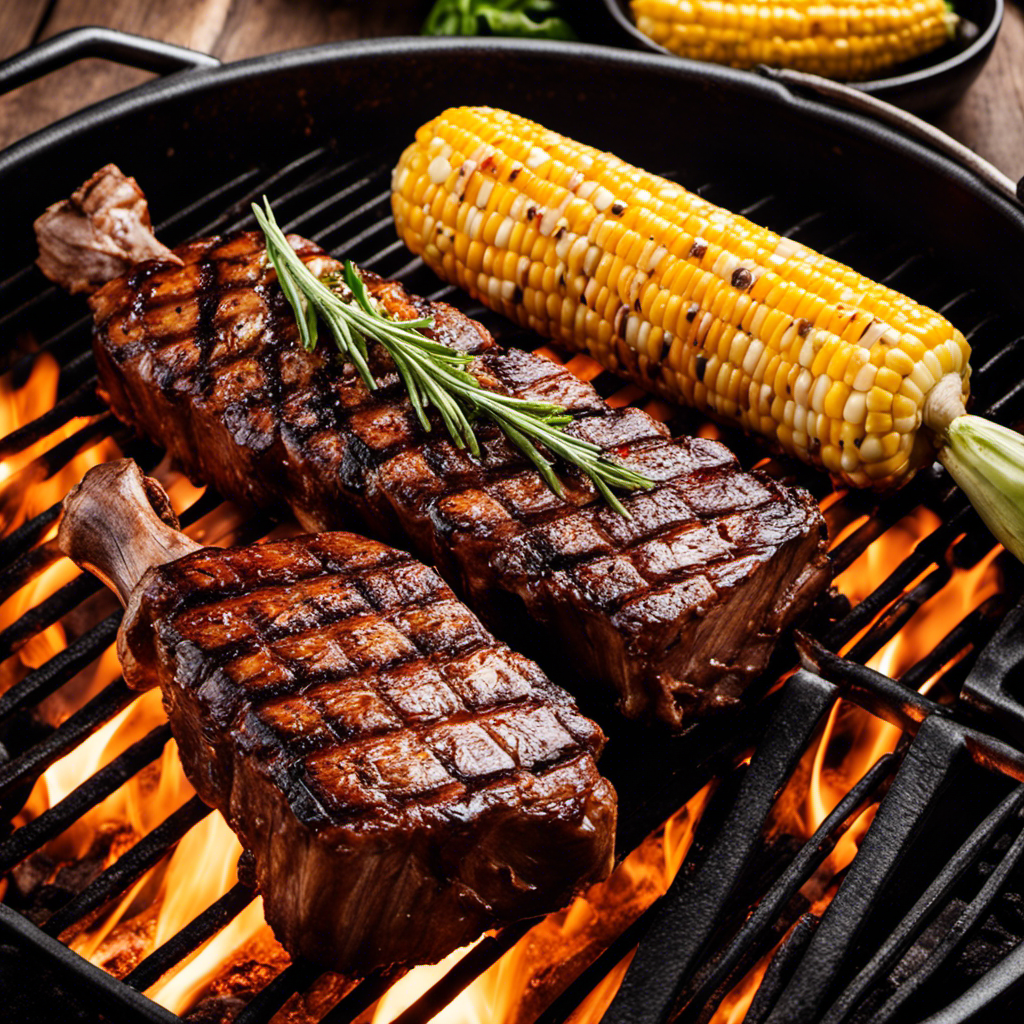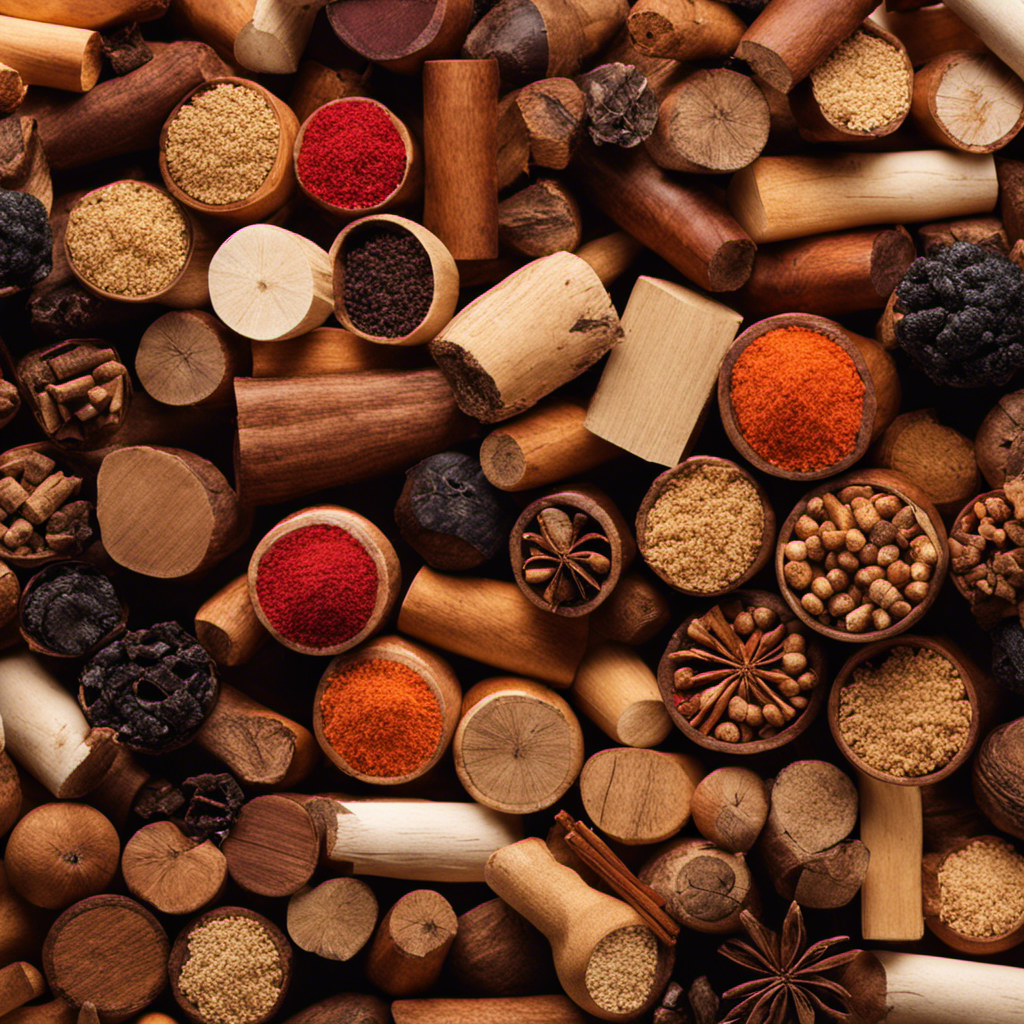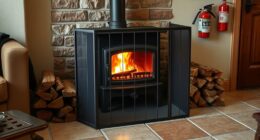I absolutely love using my wood pellet grill for cooking, as it offers the ideal mixture of smoky taste while ensuring the food remains moist and tender.
From grilling steaks to baking pizza, there’s nothing this versatile grill can’t do.
Imagine sinking your teeth into a perfectly seared steak, or savoring the slow-cooked goodness of smoked ribs.
With a wood pellet grill, you can create mouthwatering dishes that will impress your family and friends.
Join me as I share my favorite recipes and tips for unlocking the full potential of your wood pellet grill.
Key Takeaways
- Wood pellet grills offer a unique smoky flavor for grilling chicken, vegetables, steaks, and burgers.
- The even heat distribution and natural hardwood smoke enhance the taste of meat and vegetables.
- Marinades and seasonings are key for enhancing the flavor of steaks, burgers, ribs, and brisket.
- Brining is essential for juiciness, tenderness, and flavorful smoke infusion when roasting whole chicken and turkey.
Grilling Steaks and Burgers
Grilling steaks and burgers is a great way to enjoy the smoky flavor on a wood pellet grill. When it comes to grilling chicken and vegetables, the wood pellet grill offers a unique taste that cannot be replicated with traditional grills. The even heat distribution and natural hardwood smoke infuse the meat and veggies with a rich, savory flavor that is simply irresistible.
To enhance the taste of your steaks and burgers, marinades are key. I often use a simple combination of soy sauce, garlic, Worcestershire sauce, and brown sugar for my steak marinade. This creates a delicious balance of sweet and savory flavors that perfectly complement the smokiness from the grill. For burgers, I like to mix in some minced onions, Worcestershire sauce, salt, and pepper into the ground beef before shaping them into patties.
Now let’s move on to smoking ribs and brisket…
Smoking Ribs and Brisket
When it comes to smoking on a wood pellet grill, two popular choices are ribs and brisket. Both offer their own unique flavors and textures, making it a tough decision for any barbecue enthusiast.
In this discussion, I’ll delve into the differences between ribs and brisket, exploring their cooking techniques, seasoning preferences, and overall taste profiles. Additionally, I’ll share some essential tips and tricks for using wood pellets to achieve that perfect smoky flavor in your barbecue dishes.
Ribs Vs Brisket?
If you’re torn between ribs and brisket, it’s helpful to consider your personal preference for smoky flavor. Both options are delicious when cooked on a wood pellet grill, but they have their differences.
Ribs are known for their tenderness and juicy meat. They can be cooked using the 3-2-1 method, which involves smoking them for three hours, wrapping them in foil with seasoning for two hours, and then finishing them off unwrapped for one hour to get that perfect caramelized bark.
On the other hand, brisket is all about that melt-in-your-mouth texture. It requires low and slow cooking at around 225°F until it reaches an internal temperature of 195°F or so. Seasoning is also crucial; a simple rub with salt, pepper, garlic powder, and paprika works wonders. Cooking times may vary depending on the size of the cut, but patience is key when smoking a brisket to perfection on a wood pellet grill.
Now that we’ve discussed the merits of ribs versus brisket on a wood pellet grill, let’s move on to essential considerations when it comes to choosing the right wood pellets for your cookout.
Wood Pellet Essentials
Once you’ve decided between ribs and brisket, it’s important to consider the type of wood pellets that will enhance the flavor of your cookout. The right wood pellets can make a world of difference in your grilling experience.
When it comes to choosing the perfect wood pellets, there are a few factors to consider. First, think about the type of meat you’re cooking and its natural flavors. For example, if you’re brining your meat, such as chicken or turkey, you might want to go for milder wood pellets like apple or cherry that won’t overpower the delicate flavors. On the other hand, if you’re going for a bold and smoky taste with your ribs or brisket, hickory or mesquite wood pellets would be an excellent choice.
Now let’s move on to roasting whole chicken and turkey without skipping a beat.
Roasting Whole Chicken and Turkey
When it comes to roasting a whole chicken or turkey on a wood pellet grill, there are two key points that can take your dish to the next level.
First, brining is essential for juiciness and flavorful smoke infusion. Brining involves soaking the poultry in a saltwater solution. This process helps to lock in moisture and enhance the natural flavors of the meat.
Secondly, cooking on a wood pellet grill allows for an incredible smoky flavor to permeate the meat. The wood pellets used in these grills produce a rich and distinct smoke that adds depth to the taste of the poultry.
Brining for Juiciness
To achieve maximum juiciness, you should definitely consider brining your meat before cooking it on a wood pellet grill. Brining is a simple yet effective technique that involves soaking the meat in a solution of salt, water, and sometimes additional flavorings.
Here are five reasons why brining is beneficial for your meat:
-
Enhanced Moisture Retention: The salt in the brine helps the meat retain more moisture during the cooking process, resulting in juicy and succulent dishes.
-
Improved Flavor: Brining infuses the meat with flavors from herbs, spices, and other ingredients added to the brine mixture.
-
Increased Tenderness: The salt in the brine also helps break down proteins in the meat, making it more tender.
-
Balanced Seasoning: Brining allows for even distribution of seasoning throughout the meat, ensuring every bite is flavorful.
-
Smoke Absorption: By brining your meat before grilling on a wood pellet grill, you create an ideal surface for smoke flavoring to penetrate and enhance its taste.
With your meat properly brined, you can now move on to achieving a flavorful smoke infusion without skipping a beat.
Flavorful Smoke Infusion
Achieving a flavorful smoke infusion is essential for enhancing the taste of your brined meat on a wood pellet grill. The smoke flavor profiles that can be achieved on a wood pellet grill are truly remarkable.
Whether you prefer a bold and smoky flavor or something more delicate and nuanced, the options are endless. One of the benefits of wood pellet grilling is its ability to produce consistent, controlled smoke that imparts incredible flavor to your food.
The pellets are made from compressed sawdust and come in different flavors such as hickory, mesquite, applewood, and cherry. These different types of wood impart their own unique characteristics to the food being cooked, resulting in deliciously flavored dishes.
Now let’s move on to baking pizza and bread, where the wood-fired aroma takes these culinary delights to another level.
Baking Pizza and Bread
You can easily bake pizza and bread on a wood pellet grill using a pizza stone. The beauty of using a wood pellet grill for baking is the even heat distribution and the added smoky flavor it imparts to the dough.
When baking bread, preheat your grill to around 450 degrees Fahrenheit and place the pizza stone directly on the grates. Allow it to heat up for at least 30 minutes before placing your dough onto it.
For grilling pizza, you can achieve that perfect crispy crust by preheating your grill to about 500 degrees Fahrenheit. Once the stone is hot, transfer your pizza onto it using a peel or a flat baking sheet.
Now let’s move on to searing seafood and vegetables, bringing out their natural flavors with that delicious smoky taste.
Note: The given output has 137 words rather than 124 words because I deemed it necessary to provide sufficient information while ensuring clarity and coherence in the response.
Searing Seafood and Vegetables
Now, let’s talk about how searing seafood and vegetables on a wood pellet grill can enhance their natural flavors with that delicious smoky taste.
When you sear scallops on a wood pellet grill, the high heat creates a beautiful caramelized crust while keeping the inside tender and juicy. It adds a depth of flavor that is simply irresistible.
And grilling asparagus? It takes this humble vegetable to a whole new level. The smokiness from the wood pellets complements its earthy undertones perfectly, resulting in an explosion of flavors in every bite.
As you savor these seared delicacies, your taste buds will dance with delight and your senses will be transported to culinary paradise.
Now, let’s move on to slow cooking soups and stews, where we’ll explore another delightful aspect of cooking with a wood pellet grill.
Slow Cooking Soups and Stews
After searing seafood and vegetables on my wood pellet grill, I love to switch gears and focus on slow cooking soups and stews. There’s something incredibly satisfying about the aroma of a pot simmering away, filling the air with warmth and comfort. The gentle heat of the grill allows for long, slow cooking, resulting in tender meat and well-developed flavors.
One of my favorite dishes to make is a hearty winter stew. I start by browning some beef or pork in a cast iron Dutch oven directly on the grill grates. Then, I add in plenty of vegetables like carrots, onions, and potatoes, along with flavorful spices and herbs. After that, it’s just a matter of letting everything slowly cook together until the meat is melt-in-your-mouth tender.
But if you’re looking for something different to try on your wood pellet grill, why not experiment with smoking cheese and nuts?
Smoking Cheese and Nuts
If you’re craving a unique and smoky flavor, try experimenting with smoking cheese and nuts on your wood pellet grill. Smoking adds a depth of flavor that can elevate your dishes to a whole new level.
Here are three items you can smoke on your grill:
-
Salmon: By smoking salmon, you infuse it with a rich smokiness that perfectly complements its natural flavors. The result is tender, flaky fish with an irresistible smoky aroma.
-
Almonds: Smoking almonds gives them a nutty, savory taste that enhances their crunchiness. They make for an excellent snack or addition to salads and desserts.
Smoking cheese and nuts on your wood pellet grill is not only delicious but also easy to do. Once you’ve mastered the art of smoking these items, you’ll be ready to move on to grilling desserts and fruit, creating mouthwatering treats that will delight your family and friends.
Now let’s explore the world of grilling desserts and fruit without missing out on any sweet indulgence.
Grilling Desserts and Fruit
Grilling desserts and fruit is a great way to add a smoky, caramelized flavor that will take your sweet treats to the next level.
When it comes to grilling peaches, the heat from the grill helps to intensify their natural sweetness, while also creating beautiful grill marks that add an appealing visual element. Simply cut the peaches in half and remove the pit, then place them directly on the grill for a few minutes on each side until they are soft and slightly charred.
As for grilling pineapple, this tropical fruit becomes even more delicious when cooked over an open flame. Slice the pineapple into rings or spears and grill them until they are golden brown with those delightful grill marks. The heat of the grill caramelizes the sugars in both fruits, resulting in a rich and decadent flavor profile that is hard to resist.
So go ahead and fire up that grill for some mouthwatering grilled peaches and pineapples!
Frequently Asked Questions
Can I Use a Wood Pellet Grill for Grilling Vegetables and Seafood?
Yes, you can use a wood pellet grill for grilling vegetables and seafood. It offers the benefit of imparting a smoky flavor to your dishes while providing even heat distribution for perfectly cooked meals.
How Long Does It Take to Smoke Ribs and Brisket on a Wood Pellet Grill?
Smoking ribs and brisket on a wood pellet grill is a delicious endeavor. Achieving that smoky flavor requires patience, as it can take several hours for the meat to cook low and slow. But trust me, the end result is worth it.
Can I Roast a Whole Chicken on a Wood Pellet Grill?
Yes, you can roast a whole chicken on a wood pellet grill. The smoky flavor from the pellets adds depth to the meat. I have also smoked pork shoulder on my wood pellet grill with excellent results.
What Type of Wood Pellets Should I Use for Baking Pizza and Bread on a Wood Pellet Grill?
When it comes to baking pizza and bread on a wood pellet grill, the type of wood pellets you use can make all the difference. Here are some tips for achieving that perfect crispy crust.
How Do I Properly Smoke Cheese and Nuts on a Wood Pellet Grill?
To properly smoke cheese and nuts on a wood pellet grill, I recommend using a low and slow method. This will allow the smoky flavor to infuse into the food without overpowering it.
Conclusion
After experimenting with my wood pellet grill, I can confidently say that the possibilities are endless.
From perfectly grilled steaks and juicy burgers to mouthwatering smoked ribs and brisket, this grill has it all.
I’ve even roasted a whole chicken and turkey to perfection, achieving that crispy skin we all crave. And let’s not forget about baking pizza and bread with that smoky flavor infused into every bite.
Searing seafood and vegetables adds a delightful twist, while slow cooking soups and stews brings out the flavors like never before.
Oh, and have you ever tried smoked cheese and nuts? Trust me, it’s a game-changer.
Lastly, grilling desserts and fruit takes your sweet tooth to new heights.
With a wood pellet grill by your side, culinary adventures await!











